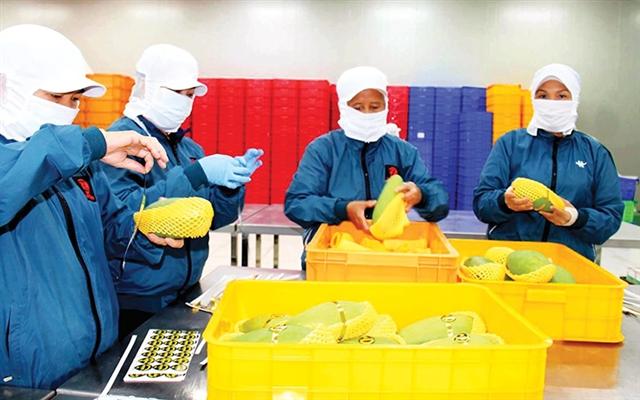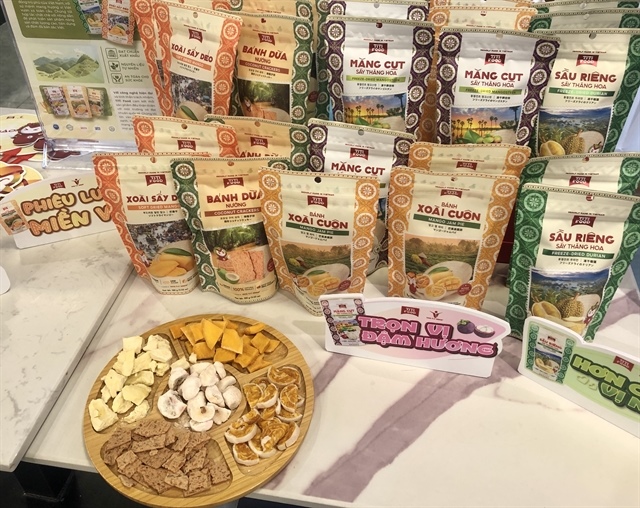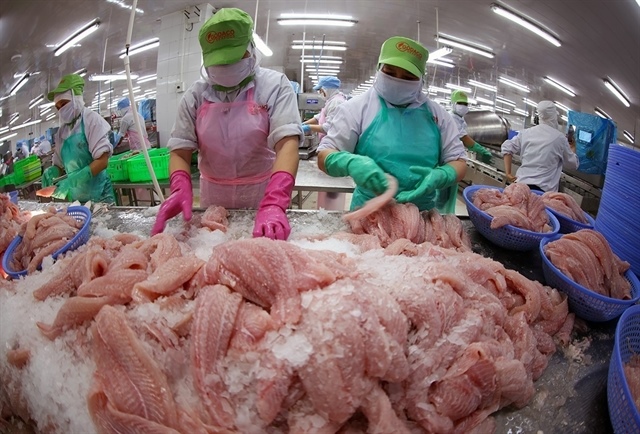Quality improvement to help fruit exporters take on rivals
Quality improvement to help fruit exporters take on rivals
With the historic EU-Vietnam Free Trade Agreement now in effect, the doors are open for Vietnamese farmers to push fruit exports to the EU. However, the strong focus on semi-processed fruit, low value products, technical barriers, and the ongoing health crisis are presenting significant hurdles before they can cash in on the agreement.

Vietnamese mango exporters are looking at bright prospects. Photo: Le Toan
|
Following the newly-implemented deal (EVFTA), Vietnamese exporters of fresh fruit can enjoy the deal’s preferential tariffs if they meet the rules of origin (ROO), among other regulations.
However, Quang Van Sy, director at Dong Tam Cooperative in the northern province of Son La, said that some of the cooperative’s mango-growing members find it difficult to implement the new rules. In addition to their complexity, farmers are also confused about issuing the right origin codes for their growing areas.
Even so, ROO is nothing new. The EU has been protecting food safety of its consumers since 1979 under the Rapid Alert System for Food and Feed (RASFF). Because of the standards in the RASFF, the bloc last year refused eight agricultural and nine seafood shipments from Vietnam – which caused not only economic loss but also damaged the sector’s reputation, according to Vietnam’s Ministry of Industry and Trade.
The EU is currently Vietnam’s fourth-largest fruit and vegetable export market. Figures from the Vietnam Fruit and Vegetables Association show that last year, Vietnam exported $148 million worth of fruit and vegetables to the EU, up 28.5 per cent compared to 2018 but only accounting for 0.08 per cent of the bloc’s total demand, as most of the exports were semi-processed, with only a fraction being processed.
Despite these improved figures, Vietnam has a short-term advantage over regional competitors, such as China and Thailand, in further increasing its exports to the EU as 94 per cent of the previous 547 tariff lines for fresh and processed fruit and vegetables are cut to zero. However, the ongoing global health crisis renders the current harvest season rather bleak since the EU remains largely locked up, supermarket chains have not returned to normal business, and traders are unable to visit Vietnam to purchase new products.
Amid this scenario, Dong Tam Cooperative’s goal of becoming one of the major fruit suppliers to the European market seems increasingly distant. “We have not received any orders,” Sy said about the situation for this year.
Last year, Dong Tam exported more than 40 tonnes of mango to Australia and France for an average price of VND22,000 ($1) per kg, with all goods being produced according to VietGap standards and labelled with correct area codes. Now, Sy is increasingly worried, lamenting, “This year’s harvest will not even offset the production costs now that domestic prices fell to only VND12,000 (50 US cents) per kg.”
|
EVFTA compliance Under the EVFTA, all businesses exporting goods from Vietnam to the EU have two options concerning compliance. Depending on their status with the Vietnamese government, exporters must either complete a certificate of origin and origin declaration form or a specialised origin declaration form. Compliance associated with these alternatives is outlined below: Certificate of origin EU-based exporters should compile information available as per Protocol 1 of the EVFTA to obtain a certificate of origin. Those seeking to export to the EU from Vietnam will have to meet requirements that, while similar to those mentioned above, are outlined in Vietnamese legislation. On June 15, Vietnam’s Ministry of Industry and Trade issued Circular No.11/2020/TT-BTC implementing the rules of origin in the EVFTA. Vietnam’s goods exported to the EU market will be granted the certificate of origin form EUR 1 to enjoy preferential tariffs under the EVFTA. The circular took effect on August 1. In addition to the application forms listed above, it may be necessary to produce any of the following supporting information: - Direct evidence of the manufacturing or other processes carried out by the exporter or supplier to obtain the goods concerned, contained for example, in his accounts or internal book-keeping; - Documents proving the originating status of materials used, issued or made out in a party, where these documents are used in accordance with domestic law; - Documents proving the working or processing of materials in a party, issued or made out in a party, where these documents are used in accordance with domestic law; and - Proof of origin proving the originating status of materials used, issued or made out in a party in accordance with this protocol. Origin declaration Made out by any exporter for consignments the total value of which is to be determined in the national legislation of Vietnam and will not exceed $6,600. Or Origin declaration Exporters that have been approved by the Vietnamese government may forgo the issuance of a certificate of origin once their approval status has been relayed to relevant EU authorities. Instead, an origin declaration will be required upon export. |
Satisfying strict criteria
Farmers and businesses all hope that the pandemic will end soon, and that Vietnamese fruit can benefit from the EVFTA. Their hope of increasing exports to this market of nearly 600 million people seems reasonable, considering data from the EU’s Centre for Promotion of Imports from developing countries.
Accordingly, the EU accounts for 45 per cent of the global fruit and vegetable trade, while the number of the bloc’s own farms is on a downward trend. The total value of EU fruit imports in the last five years has increased faster than the export volume (approximately 30 and 24 per cent, respectively).
However, the real benefits of the EVFTA can only be reaped if Vietnamese fruit and vegetables meet the EU’s strict criteria for food safety and quality, while outdoing similar products from regional rivals.
Bui Xuan Hoang, general director at Hoan Vu Co., Ltd. in Ho Chi Minh City, said that one of the biggest barriers at the moment is the weak preservation of products, with only 10 per cent qualifying for the high standards of markets like the EU and the US. The weak preservation, together with the associated high rate of loss, is also reason for rising prices such as for dragon fruit which currently sells at around $12 per kg.
“Vietnam has still room to increase its fruit exports to the EU but investment in the development of this industry is not only about meeting ROO but also about processing, preservation, and post-harvest management,” said Dr. Nguyen Van Hoa, deputy director of the Southern Horticultural Research Institute. “Vietnamese fruit is not inferior to Thailand or China, but weaknesses in production, processing, and promotion are reducing our competitiveness in the EU,” Hoa added.
Nonetheless, competition with Thailand may remain fierce, even if Vietnamese fruit is supported by tariff cuts and other incentives from the EVFTA, according to Hoa. More than 30 years ago, the Thai government prioritised investment in developing export-oriented agriculture, focusing on research and development of fruit varieties for high yield.
Additionally, the dynamics of Thailand’s agriculture is another point that Hoa delved into. “As soon as Thailand saw the EU market becoming over-saturated with fresh fruit, it switched its production to processed products,” Hoa said. “Moreover, the kingdom is using its geographical advantages by buying fresh fruit from Vietnam for processing it before sending it to the EU, only using parts of the imported produce for domestic consumption.”
Protecting health
According to Vietnam’s Ministry of Agriculture and Rural Development, exports of vegetables and fruit to Thailand in the first seven months of 2020 increased by 234 per cent compared to the same period last year, reaching $79 million – $56 million more than in 2019.
Meanwhile, Vietnam’s agricultural model focuses strongly on productivity to boost production. Even though this practice has increased fruit exports (pandemic aside), Vietnam’s fruit lacks quality and offers little added value.
In its 2020 Whitebook which highlights European businesses’ policy recommendations to the Vietnamese government, the European Chamber of Commerce in Vietnam (EuroCham) warned against the use of chemicals for fruit and vegetable production. The organisation also recommends that production management should be tightened, especially when it comes to the use of chemical preservation products. Moreover, EuroCham advises not to allow the use of those preservatives that could harm human health or the environment.
It is no coincidence that EuroCham makes these recommendations as last year’s data by the Research Institute of Organic Agriculture and the International Federation of Organic Agriculture shows that the EU, together with many other markets, is continuously tightening laws related to pesticides and preservatives.
The regulations have listed up to 600 pesticide molecules, with most of these already banned in many countries. For instance, carbendazim is manufactured and marketed as a fungicide by several Chinese companies, but because it can disrupt hormone activity in animals, it is not approved for use in most countries. Nevertheless, it can still sometimes be found used for citrus fruits like lemons, oranges, and tangerines.
According to experts, before increasing fruit exports to the EU, domestic producers may first need to cope with the current challenges, which are forecast to possibly last until the end of the year or well beyond that.






















